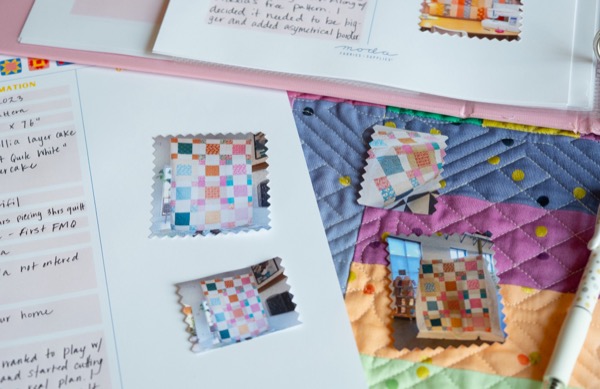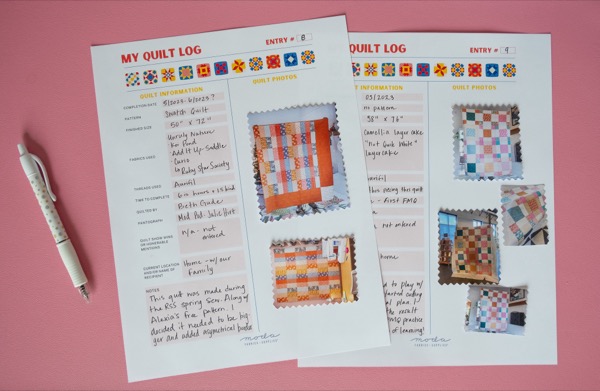Welcome to Moda Fabrics!
Preserving the Stories Behind Our Quilts: Start Your Own Quilt Archive
Preserving the Stories Behind Our Quilts: Start Your Own Quilt Archive
The Quest for Bertha: A Quilt Detective's Journey
Inspired by the fascinating article, Desperately Seeking Bertha: Becoming a Quilt Detective, I am reminded of the importance of documenting and preserving the stories behind our quilts. Imagine in your lifetime how much time you will have dedicated to this craft and artform? The journey to uncover Bertha’s quilt history is a testament to the power of archives. Mary Fons has been diligently tracking down Bertha’s works for a while now…and thank goodness there was a log. It gave her a place to start.
Who Was Bertha?

Bertha Meckstroth (c. 1930-40). This photo was featured on the cover of the Fall 1981 issue of Quilter’s Journal, Vol. 4, No. 3. The photo attended an article about the artist written by Joyce Gross.
Bertha was a passionate quilter whose creations captured the hearts of many. She left very detailed instructions for what should happen to her quilts after she passed, she even left behind a considerable sum of money to make sure they were looked after and taken care of appropriately.
Her works are very interesting, lots of applique and reverse applique. Her family had ties to the textile world so she also had incredible fabrics to use.
After her passing, sadly, her wishes were completely abandoned. At the time this was a newsworthy headline “Crazy Lady Leaves Behind Thousands for her Quilts!” Her quilts became scattered, and the rich history embedded in each stitch risked being lost forever.
The Fate of Bertha’s Quilts

Bertha’s 1934 personal coat of arms with her initials “B.A.M.” above the phrase “Beautiful and Industrious” in Latin. Thisand 14 other Meckstroth quilts are in the permanent collection of the International Quilt Museum. Click here to explore the IQM’s collection of more than 6,000 quilts and quilt objects using their online “Search the Collection” feature.
Thanks to the dedication of quilt detectives, headed by Mary Fons of Quiltfolk, the stories behind Bertha's quilts are being rediscovered. These quilty sleuths trace the paths of her quilts, reconnecting them with Bertha’s narrative and ensuring her legacy endures.

Easter Quilt (1933), in the collection of the Museum of Fine Arts Boston. (Museum purchase with funds donated by the Textile & Costume Society, Museum of Fine Arts, Boston.) https://www.mfa.org/
The detective work to locate these quilts has not only brought joy to their new owners but has also woven a tapestry of stories that celebrate Bertha's artistry. These efforts highlight the importance of tracking the provenance and journey of each quilt, preserving their history for future generations.
Why Document Your Quilts?
Just like Bertha’s quilts, your creations hold a wealth of memories and stories that future generations will cherish. Documenting your quilts ensures that these stories aren’t lost. It allows you to track the location of your quilts, understand their journey, and keep the legacy of your quilting art alive. While it is always a good practice to label your quilts with a sew on or sew in label we also think building a Quilt Archive is important.

Introducing Moda’s Quilt Log Document
To help you start your own quilt archive, we’ve created a Quilt Log Document that you can download for free. This comprehensive log will help you record the details of each quilt you make or own. Here’s what you can expect from the log:
- Quilt Details: Document the name, dimensions, and materials used.
- Creation Story: Share the inspiration, process, and any special memories associated with the quilt.
- Ownership History: Keep track of who owns the quilt and any changes in ownership over time.
- Photographic Record: Attach photos of your quilt at various stages of its creation and completion.
- Location Tracking: Ensure you always know where your quilts are, whether they’re displayed, gifted, or stored.
Once you download the .zip file you will see there are two documents.
One is a .pdf which you can print out and use your handwriting to fill in the log and your favorite washi tape to print out and attach photos!

You can also open this .pdf in Acrobat and use the Edit function to fill in text and import photos.
We also included a .ai file. Knowing many quilters are comfortable with the Adobe Suite we wanted to provide a form with text boxes and spots to add digital images! Make sure you save each as its own file so that you can update the log as needed!

There are many different ways to work with these files and we trust you will find the one that works for you! The most important thing is that you are documenting!
Start Your Quilting Archive Today!

Preserving the history of your quilts doesn’t have to be a daunting task. With our Quilt Log Document, you can easily keep track of your precious creations and the stories they hold. Download the document now and start building your quilt archive. Your future self – and future generations – will thank you!
Download the Free Quilt Log Documents Here
>>You will need to unzip the file to get the .pdf file as well as the Adobe Illustrator Template.
Share Your Stories
We’d love to hear about your quilting journey and the stories behind your quilts. Share your experiences with us on social media using the hashtag #MyQuiltLog. Let’s celebrate the art of quilting and the rich histories behind each piece together!
Follow Moda Fabrics for More Fun Content!
Stay tuned for exciting tutorials, tips and inspiration! Follow us on Instagram, Facebook and Youtube to join our vibrant quilting, sewing and crafting community!
- Subscribe to Moda Fabric’s Youtube
- Follow Moda on Instagram
- Follow Moda on Facebook
